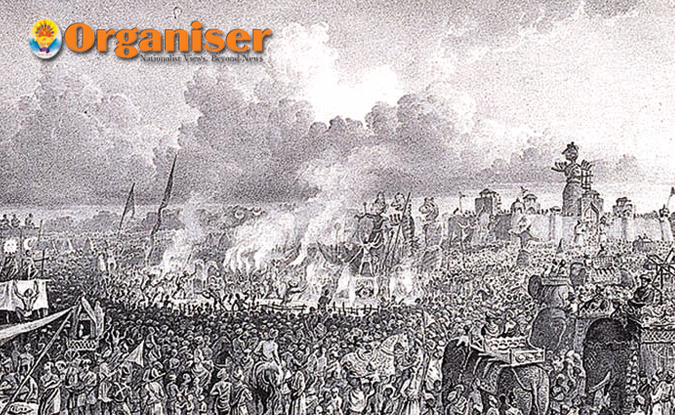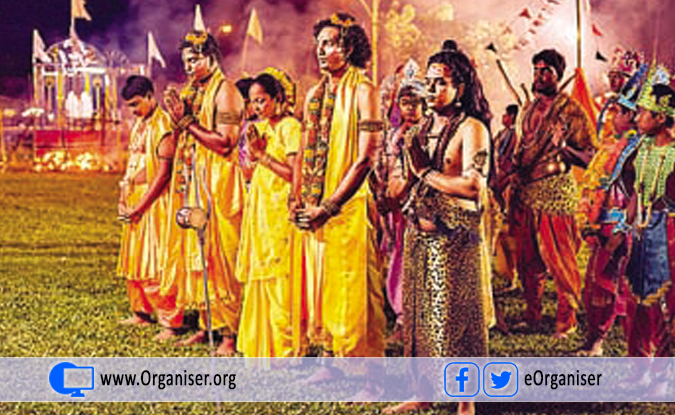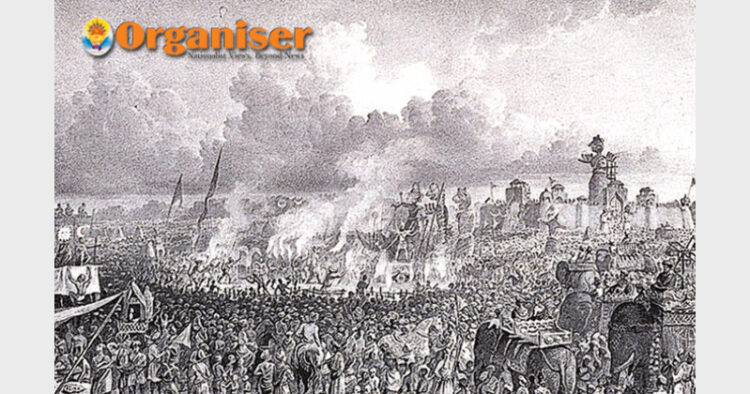Lok in Bharat was and remains the mainstream. The journey of Ramlila along with the indentured labourers in the past provides a case study to substantiate the claim
Over the centuries, Ramlila has evolved into a highly venerated art form and has travelled to far corners of the globe, through Indian diaspora, not as acts of “cultural recovery”, rather as fresh expressions of a persistent faith. Today, Ramalila is staged in most countries those with immigrant Hindu populations from the Indian subcontinent, including from India, Nepal and Pakistan. Outside the Indian subcontinent, this includes Fiji, Mauritius, South Africa, Canada, Guyana, Suriname, Trinidad and Tobago, Great Britain, The Netherlands, the United States, and Australia. Some Asian cultures have similar drama traditions based on the Ramayana, for instance, the Phra Lak Phra Lam (Lak and Lam are the Laotian names for Lakshman and Ram, respectively) folk play of Laos and northeastern Thailand.

Ramlila Mela before the Raja of Benares culmination of Ramlila with burning of Ravana effigies at Ramnagar Fort 1834, Credit- Wikipedia Commons
The Rama story is also enacted in another popular art form as a nighttime fire shadow or daytime puppet show. It is known as Tolapavakuthu in Kerala, Ravanachaya in Odisha, Nang sbek them in Cambodia, Nang yai in Thailand and Wayang purwa in Indonesia.
We are well aware of the Ram Leela tradition in South-east Asia because of the Hindu engagement since the ancient times. However, one must ponder that how Ram Leela reached far-away lands like Americas?
National to Global
The answer again lies in the transportation of same community of people who were de-notified as criminal tribes by the Colonial State. Many members of such nomadic communities were transported to Africa and the Americas by the Colonial State during the late 19th and early 20th century. Consider the example of Trinidad. Indentured labourers were brought to Trinidad from India between 1845 and 1917. The 143, 939 men, women and children who came were mostly Hindus (Brereton 1996, 59). They brought their culture with them, including the Ramleela tradition. The Ramleela began in Trinidad soon after the arrival of the indentured labourers, in fact within the first forty years of their coming to Trinidad.

Ramlila in Trinidad and Tobago
Certainly, the wandering communities and many other Indian locals who were not literate, least ‘educated’ in the exclusionary colonial education system, knew about the Ramayana. They must not have read the text! However, they knew the tales of Sri Ram of Ayodhya and his quest to Lanka. The source of knowledge, in this case, came from the popular representation of the text, which was staged during Ram Leela, majorly in Dushhera, and by the behrupiyas during the whole year.
To substantiate the above argument, let’s take the example of the language in which the performances have been done in Trinidad. The languages used in the Ramlila plays have evolved over the years. According to a pundit of Charlieville (central Trinidad), “It is believed that the first performance of Ramlila in Trinidad was rendered in Bhojpuri. As early as the 1880s, Bhojpuri was spoken by indentured Indians in Trinidad. Therefore, memorising, understanding and chanting of the Ramcharitmanas in Bhojpuri as well as watching and acting in Ramlila plays were not an impossible task. The choupais [four line verses] from the Ramcharitmanas was read in Avadhi and explained in Bhojpuri.”
Vanishing Tradition!
The Waghya Murali, Potraj, Vasudev and Gondhali communities have managed to keep alive their unique cultures and vibrant art, enriching the cultural tapestry of Maharashtra with their engaging traditions. But neither the government nor any concerned organisation or institution has done much to ensure the continuation of these communities’ culture and tradition, even as they have faded into an obscurity that verge on the brink of extinction.Faced with the everyday reality of procuring the basic needs of food, shelter and education for their children, the members of these communities have been forced to abandon their beloved traditions.

Street singers fortune tellers dramatic performers the Potraj Vasudev Gondhali and Kudmude Joshi communities were once a vital part of the cultural and devotional life of Maharashtra
In the late 1950s, the translation of the choupais was changed from Bhojpuri to Standard English as most of the children of the indentured labourers were being introduced to the English language through school systems. Ramlila plays in Bhojpuri were no longer understood by the younger generations. By 1970s, English had nearly replaced Bhojpuri for speaking with fellow Hindus, except elderly monolingual kin.
The whole trajectory of the evolution underlines one fact- localised tradition becoming global. But this would not have been possible in the first place, had there not been a Bhojpuri rendition of Ramayana available in the memory of Indian indentured labourers. It must have reached to them, and sustained after that, because of the popular representations of the text and telling, by the behrupiyas and Ramlila mandalis.
We must, therefore, conclude that art forms like behroop, have played a very crucial part in the dissemination of knowledge in the popular domain. They assisted in the transmission, circulation and popularisation of the ideas through storytelling. And that assured the continuation of different knowledge forms despite many changes and breaks in the timeline of Bharatiya discourse.














Comments